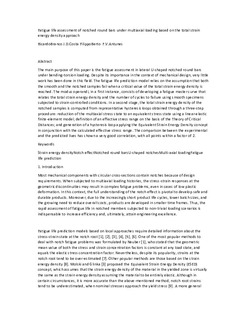| dc.contributor.author | Branco, Ricardo | |
| dc.contributor.author | Costa, JD | |
| dc.contributor.author | Berto, Filippo | |
| dc.contributor.author | Antunes, F.V. | |
| dc.date.accessioned | 2019-02-26T09:10:32Z | |
| dc.date.available | 2019-02-26T09:10:32Z | |
| dc.date.created | 2018-10-26T15:34:00Z | |
| dc.date.issued | 2018 | |
| dc.identifier.citation | Theoretical and applied fracture mechanics (Print). 2018, 97 340-348. | nb_NO |
| dc.identifier.issn | 0167-8442 | |
| dc.identifier.uri | http://hdl.handle.net/11250/2587368 | |
| dc.description.abstract | The main purpose of this paper is the fatigue assessment in lateral U-shaped notched round bars under bending-torsion loading. Despite its importance in the context of mechanical design, very little work has been done in this field. The fatigue life prediction model relies on the assumption that both the smooth and the notched samples fail when a critical value of the total strain energy density is reached. The modus operandi, in a first instance, consists of developing a fatigue master curve that relates the total strain energy density and the number of cycles to failure using smooth specimens subjected to strain-controlled conditions. In a second stage, the total strain energy density of the notched samples is computed from representative hysteresis loops obtained through a three-step procedure: reduction of the multiaxial stress state to an equivalent stress state using a linear-elastic finite-element model; definition of an effective stress range on the basis of the Theory of Critical Distances; and generation of a hysteresis loop applying the Equivalent Strain Energy Density concept in conjunction with the calculated effective stress range. The comparison between the experimental and the predicted lives has shown a very good correlation, with all points within a factor of 2. | nb_NO |
| dc.language.iso | eng | nb_NO |
| dc.publisher | Elsevier | nb_NO |
| dc.title | Fatigue life assessment of notched round bars under multiaxial loading based on the total strain energy density approach | nb_NO |
| dc.type | Journal article | nb_NO |
| dc.description.version | submittedVersion | nb_NO |
| dc.source.pagenumber | 340-348 | nb_NO |
| dc.source.volume | 97 | nb_NO |
| dc.source.journal | Theoretical and applied fracture mechanics (Print) | nb_NO |
| dc.identifier.doi | 10.1016/j.tafmec.2017.06.003 | |
| dc.identifier.cristin | 1623977 | |
| dc.description.localcode | This is a submitted manuscript of an article published by Elsevier Ltd in Theoretical and applied fracture mechanics, 14 June 2017. | nb_NO |
| cristin.unitcode | 194,64,92,0 | |
| cristin.unitname | Institutt for maskinteknikk og produksjon | |
| cristin.ispublished | true | |
| cristin.fulltext | postprint | |
| cristin.fulltext | preprint | |
| cristin.qualitycode | 1 | |
